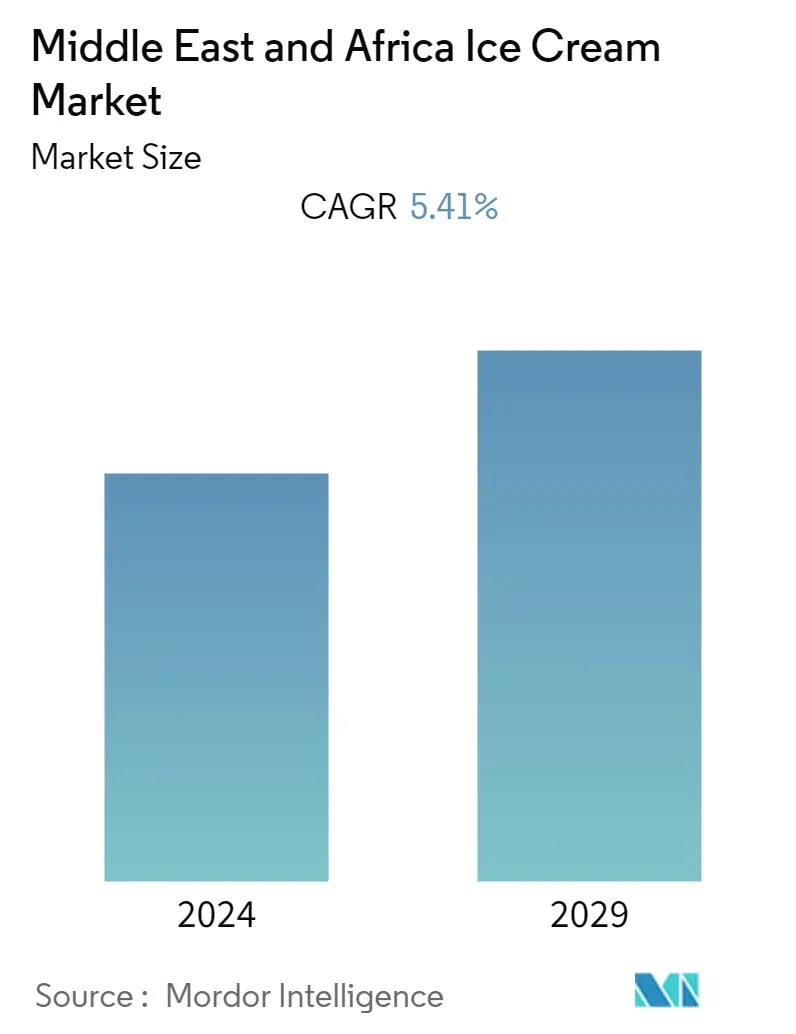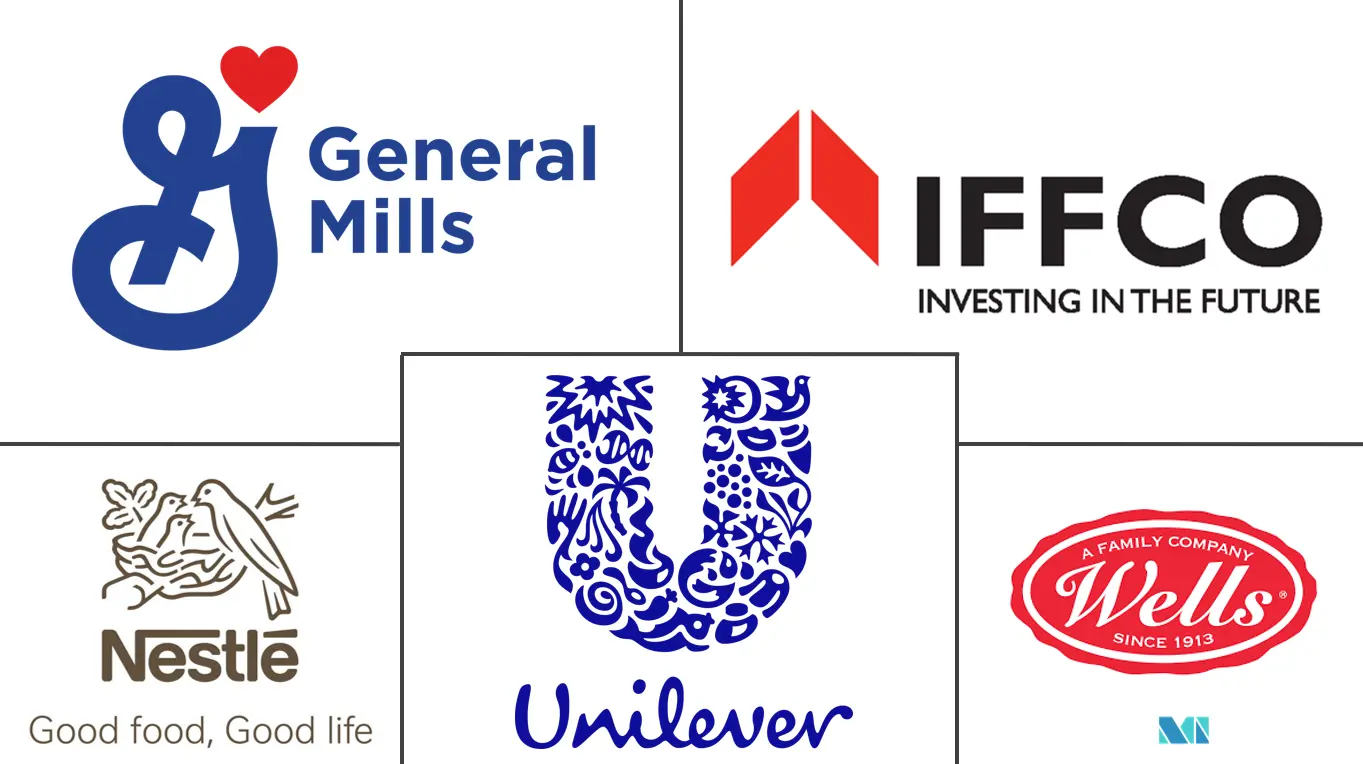Market Size of Middle East & Africa Ice Cream Industry

| Study Period | 2019 - 2029 |
| Base Year For Estimation | 2023 |
| Forecast Data Period | 2024 - 2029 |
| Historical Data Period | 2019 - 2022 |
| CAGR | 5.41 % |
| Market Concentration | Low |
Major Players
*Disclaimer: Major Players sorted in no particular order |
Middle East Africa Ice Cream Market Analysis
The Middle East & Africa ice cream market was valued at USD 80.61 billion for the current year and is projected to register a CAGR of 5.41% over the next five years.
- The Middle East and African ice cream market is growing significantly due to the increased consumption and sales of ice cream. This briefs the need for consumers to continually experiment with new flavors and tastes of ice cream to not saturate with conventional offerings.
- As a result, the major ice cream brands, Baskin-Robbins and Haagen-Dazs, ice cream are well catering to the growing demand for development and innovations in the industry. Branded and private-labeled ice creams comprise a vital part of the Middle East & African frozen dessert market. Additionally, the shift in consumer preference toward the vegan diet and the growing lactose intolerance population improved demand for the non-dairy ice cream category across the region. This, in turn, is augmenting the growth of the ice cream market in the region.
- There is also a rise in demand for premium ice creams, which will be one of the primary factors driving the market growth. Premium ice creams have become a popular product among health-conscious consumers due to the presence of high-quality ingredients and a lower amount of aeration than regular ice creams.
- Furthermore, a growing preference for natural, less processed, and convenient food and an increasing focus on low-calorie ice creams are enabling companies to tap the growth potential of the market. For instance, in December 2021, Thrivv, a healthy food brand based in the United Arab Emirates, launched keto-friendly bread, jam, and ice cream for people with diabetes on its e-commerce store and Noon Daily, Kinsons, and Shop Kitopi as well. The market in the region is therefore expected to grow due to these factors.
Middle East Africa Ice Cream Industry Segmentation
Ice cream is a frozen dessert made using milk, cream, and artificial or natural flavorings.
The Middle East & African ice cream market is segmented into product type, distribution channel, and geography. By product type, the market is segmented into impulse ice cream, take-home ice cream, and artisanal ice cream. Based on the distribution channel, the market is segmented into supermarkets/hypermarkets, convenience stores, specialist stores, online retail stores, and other distribution channels. Based on geography, the market includes major geographies across the region, South Africa, Saudi Arabia, the United Arab Emirates, and the Rest of the Middle East & Africa.
For each segment, the market sizing and forecasts have been done on the basis of value (in USD million).
| Product Type | |
| Impulse Ice Cream | |
| Take Home Ice Cream | |
| Artisanal Ice Cream |
| Distribution Channel | |
| Supermarkets/Hypermarkets | |
| Convenience Stores | |
| Specialist Stores | |
| Online Retail Stores | |
| Other Distribution Channels |
| Geography | |
| South Africa | |
| Saudi Arabia | |
| United Arab Emirates | |
| Rest of Middle-East and Africa |
Middle East & Africa Ice Cream Market Size Summary
The Middle East and Africa ice cream market is experiencing robust growth, driven by increasing consumer demand for diverse flavors and innovative offerings. This trend is supported by major brands like Baskin-Robbins and Haagen-Dazs, which are actively catering to the evolving preferences of consumers. The market is characterized by a significant presence of both branded and private-labeled ice creams, with a notable shift towards non-dairy options due to rising lactose intolerance and a growing vegan population. The demand for premium ice creams is also on the rise, as health-conscious consumers seek products with high-quality ingredients and lower aeration. Companies are capitalizing on this trend by introducing natural, less processed, and low-calorie options, further fueling market expansion.
The market landscape is highly competitive, with numerous regional and international players such as Unilever, General Mills Inc, Nestle, IFFCO Group, and Wells Enterprises Inc. These companies are focusing on product innovation and development to meet consumer demands for varied tastes and premium quality. The fragmented nature of the market is marked by strategic mergers and acquisitions, enabling key players to maintain a dominant position. The entry of multinational manufacturers and the growth of the tourism and restaurant sectors are expected to further bolster the market. The introduction of exotic flavors and artisanal offerings, such as those by Canvas Gelato, highlights the ongoing innovation within the industry, catering to both local and expatriate consumers in the region.
Middle East & Africa Ice Cream Market Size - Table of Contents
-
1. MARKET DYNAMICS
-
1.1 Market Drivers
-
1.1.1 Demand for Low-fat and Non-Dairy Ice Cream Products
-
1.1.2 Growing Acceptance of Experimental Flavors
-
-
1.2 Market Restraints
-
1.2.1 Rising Concern over Health Issues Associated with Ice Cream
-
-
1.3 Porter's Five Forces Analysis
-
1.3.1 Threat of New Entrants
-
1.3.2 Bargaining Power of Buyers/Consumers
-
1.3.3 Bargaining Power of Suppliers
-
1.3.4 Threat of Substitute Products
-
1.3.5 Intensity of Competitive Rivalry
-
-
-
2. MARKET SEGMENTATION
-
2.1 Product Type
-
2.1.1 Impulse Ice Cream
-
2.1.2 Take Home Ice Cream
-
2.1.3 Artisanal Ice Cream
-
-
2.2 Distribution Channel
-
2.2.1 Supermarkets/Hypermarkets
-
2.2.2 Convenience Stores
-
2.2.3 Specialist Stores
-
2.2.4 Online Retail Stores
-
2.2.5 Other Distribution Channels
-
-
2.3 Geography
-
2.3.1 South Africa
-
2.3.2 Saudi Arabia
-
2.3.3 United Arab Emirates
-
2.3.4 Rest of Middle-East and Africa
-
-
Middle East & Africa Ice Cream Market Size FAQs
What is the current Middle East & Africa Ice Cream Market size?
The Middle East & Africa Ice Cream Market is projected to register a CAGR of 5.41% during the forecast period (2024-2029)
Who are the key players in Middle East & Africa Ice Cream Market?
General Mills, Inc., IFFCO Group, Nestlé S.A., Unilever PLC and Wells Enterprises, Inc. are the major companies operating in the Middle East & Africa Ice Cream Market.

